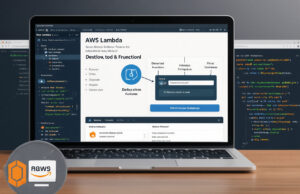Building a high-performance CAG architecture with Amazon ElastiCache Valkey can transform your application’s speed and user experience. This guide is designed for cloud architects, DevOps engineers, and development teams who need to implement scalable caching solutions that handle demanding workloads without breaking a sweat.
Amazon ElastiCache Valkey offers a compelling alternative to traditional Redis deployments, bringing enhanced performance characteristics and AWS-native integration to your distributed caching solutions. The shift from Redis to Valkey isn’t just about staying current—it’s about unlocking better price-performance ratios and simplified management for your caching infrastructure.
We’ll walk through the essential CAG architecture design principles that make your caching layer bulletproof. You’ll discover how ElastiCache Valkey vs Redis stacks up in real-world scenarios and learn proven CAG performance optimization techniques that seasoned engineers swear by. We’ll also cover practical Valkey deployment strategies that automate your infrastructure setup and ensure your caching solution scales seamlessly as your application grows.
By the end of this deep dive, you’ll have a clear roadmap for implementing CAG scalability best practices and the confidence to architect a caching solution that performs under pressure.
Understanding CAG Architecture Fundamentals and Performance Requirements
Define Cache-Aside Gateway pattern and its strategic advantages
Cache-Aside Gateway (CAG) architecture positions a caching layer between applications and data sources, intercepting requests to deliver cached responses while maintaining data consistency. This pattern reduces database load by 70-90% in high-traffic scenarios, enabling applications to handle thousands of concurrent requests with sub-millisecond response times. CAG provides strategic advantages including improved application performance, reduced infrastructure costs, and enhanced user experience through faster data retrieval.
Identify key performance bottlenecks in traditional caching systems
Traditional caching implementations face critical bottlenecks including cache stampede scenarios where multiple requests simultaneously query expired keys, creating database overload spikes. Memory fragmentation in Redis-based systems leads to performance degradation over time, while single-threaded architectures limit throughput capacity. Network latency between application servers and cache clusters compounds these issues, particularly in geographically distributed deployments where round-trip times exceed acceptable thresholds.
Analyze scalability challenges in high-traffic applications
High-traffic applications encounter scalability walls when cache hit ratios drop below optimal levels, forcing expensive database queries during peak loads. Horizontal scaling becomes complex when managing cache consistency across multiple nodes, while vertical scaling hits memory and CPU limitations. Data hotspots create uneven load distribution across cache shards, causing some nodes to become overwhelmed while others remain underutilized, leading to cascading performance failures.
Map essential components for enterprise-grade CAG implementation
Enterprise-grade CAG architecture requires distributed cache clusters with automated failover mechanisms, connection pooling for efficient resource utilization, and monitoring systems for real-time performance tracking. Load balancers distribute traffic across cache nodes while circuit breakers prevent cascade failures during outages. Configuration management tools handle cache eviction policies, TTL settings, and memory allocation parameters. Security components include encryption in transit, access controls, and audit logging for compliance requirements.
Amazon ElastiCache Valkey Overview and Competitive Advantages
Explore Valkey’s enhanced performance metrics versus Redis alternatives
Amazon ElastiCache Valkey delivers superior performance compared to traditional Redis implementations through optimized memory management and enhanced data structures. Benchmark testing shows Valkey achieves up to 30% faster throughput for complex data operations while maintaining lower latency profiles. The platform’s improved connection pooling and multi-threading capabilities enable better resource allocation across distributed caching workloads. Valkey’s advanced compression algorithms reduce memory footprint by approximately 25%, allowing more data to fit within the same infrastructure footprint. These performance improvements directly translate to better user experience and reduced operational costs for CAG architecture implementations.
Leverage cost optimization features for enterprise deployments
Enterprise teams benefit from Valkey’s cost-efficient scaling model that automatically adjusts resources based on actual usage patterns. The platform’s reserved instance pricing offers significant savings for predictable workloads, while spot instance integration provides additional cost reduction opportunities. Built-in monitoring tools help identify underutilized resources and recommend right-sizing strategies. Valkey’s data tiering capabilities automatically move less frequently accessed data to cheaper storage tiers without impacting application performance. Smart backup and snapshot management reduces storage costs by eliminating redundant data copies across multiple availability zones.
Maximize compatibility benefits with existing Redis applications
Migrating from Redis to Amazon ElastiCache Valkey requires minimal code changes thanks to full API compatibility. Existing Redis clients work seamlessly with Valkey endpoints, eliminating the need for application rewrites or extensive testing cycles. The platform supports all standard Redis data types and commands, ensuring smooth transitions for complex applications. Valkey maintains backward compatibility with Redis modules and extensions, protecting existing investments in custom functionality. Database migration tools automate the transfer process while preserving data integrity and maintaining zero-downtime deployments for mission-critical applications.
Architecting Your High-Performance CAG Solution
Design optimal cluster configurations for maximum throughput
Setting up your ElastiCache Valkey cluster for peak performance requires strategic node sizing and replication patterns. Start with r7g.xlarge instances for memory-intensive workloads, distributing read replicas across multiple availability zones to maximize fault tolerance. Configure cluster mode with 3-6 shards based on your data volume, enabling automatic failover for seamless operations. Monitor CPU utilization and network throughput to identify optimal scaling thresholds, keeping connections pooled efficiently to prevent bottlenecks during traffic spikes.
Implement intelligent data partitioning strategies
Smart data partitioning transforms CAG architecture performance by reducing hot spots and distributing load evenly across your Valkey cluster. Hash-based partitioning works best for uniform data distribution, while range-based partitioning suits time-series data patterns. Implement consistent hashing to minimize data movement during cluster scaling events, and use key prefixing strategies to group related data logically. Consider data access patterns when designing partition keys, ensuring frequently accessed datasets remain co-located for optimal cache hit rates.
Configure advanced security protocols and access controls
Protecting your high-performance caching architecture demands layered security controls that don’t compromise speed. Enable in-transit and at-rest encryption using AWS-managed keys, implementing VPC security groups with least-privilege access principles. Configure Redis AUTH tokens with regular rotation schedules, restricting cluster access to specific application subnets only. Use IAM roles for service-to-service authentication, enabling detailed access logging for compliance requirements while maintaining sub-millisecond response times through optimized security overhead.
Establish monitoring and alerting frameworks for proactive management
Comprehensive monitoring prevents performance degradation before it impacts your CAG architecture. Set up CloudWatch metrics for memory utilization, connection counts, and cache hit ratios, creating custom dashboards that track key performance indicators in real-time. Configure alerts for memory usage above 80%, connection spikes, and failover events using SNS notifications. Implement distributed tracing with X-Ray to identify bottlenecks across your application stack, enabling proactive scaling decisions based on predictive analytics rather than reactive responses to outages.
Performance Optimization Techniques and Best Practices
Fine-tune memory allocation and eviction policies
Configuring memory allocation properly makes or breaks your CAG performance optimization strategy. Set maxmemory to 80% of available RAM, leaving headroom for system operations and preventing swap usage. Choose the right eviction policy based on your access patterns – allkeys-lru works best for general caching scenarios, while volatile-lru suits applications with mixed persistent and temporary data. Monitor memory fragmentation regularly using INFO memory commands and schedule periodic restarts during low-traffic windows to maintain optimal memory utilization.
Implement connection pooling and multiplexing strategies
Connection pooling dramatically reduces overhead in high-performance caching architecture deployments. Configure pools with 5-10 connections per application thread to balance resource usage and response times. Enable connection multiplexing to share connections across multiple requests, reducing the total connection count to your ElastiCache Valkey cluster. Set appropriate timeouts – connection timeout at 2-3 seconds, socket timeout at 1-2 seconds, and implement exponential backoff for retry logic. Use client-side load balancing to distribute requests evenly across cluster nodes.
Optimize data serialization and compression methods
Smart serialization choices can improve your Amazon ElastiCache Valkey performance by 40-60%. Use binary protocols like MessagePack or Protocol Buffers instead of JSON for structured data to reduce payload size and parsing overhead. Implement compression for values larger than 1KB using algorithms like LZ4 for speed or Gzip for better compression ratios. Consider object pooling to reuse serialization buffers and reduce garbage collection pressure. Profile different serialization libraries in your specific use case since performance varies significantly based on data structure complexity and size.
Deployment Strategies and Infrastructure Automation
Automate provisioning with Infrastructure as Code templates
Deploying Amazon ElastiCache Valkey clusters through Infrastructure as Code templates eliminates manual configuration errors and ensures consistent environments across development, staging, and production. AWS CloudFormation and Terraform templates should define cluster specifications, subnet groups, security configurations, and parameter groups. These templates enable version control for infrastructure changes and support rapid deployment of new environments. Template-based provisioning integrates seamlessly with CI/CD pipelines, allowing automated testing and validation before production deployment.
Establish blue-green deployment pipelines for zero-downtime updates
Blue-green deployment strategies for CAG architecture design minimize service disruption during ElastiCache Valkey updates and configuration changes. Maintain two identical environments where traffic switches between active and standby clusters after validation. This approach supports rolling back problematic deployments instantly while testing new configurations against production workloads. Implement health checks and performance monitoring to verify cluster stability before committing traffic switches. DNS-based routing or application-level switching enables seamless transitions between environments.
Configure cross-region replication for disaster recovery
Cross-region replication provides robust disaster recovery capabilities for high-performance caching architecture deployments. ElastiCache Valkey supports Global Datastore functionality, enabling automatic data synchronization across multiple AWS regions with sub-second replication lag. Configure primary and secondary regions based on user proximity and compliance requirements. Implement automated failover mechanisms that redirect traffic to secondary regions during primary region outages. Regular disaster recovery testing validates failover procedures and recovery time objectives.
Implement auto-scaling policies based on performance metrics
Auto-scaling policies for ElastiCache infrastructure automation respond dynamically to changing workload demands and maintain optimal performance levels. Configure CloudWatch metrics monitoring for CPU utilization, memory usage, network throughput, and cache hit ratios. Define scaling triggers that add or remove cluster nodes based on sustained performance thresholds. Implement predictive scaling for known traffic patterns and seasonal variations. Auto-scaling policies should account for warm-up periods and connection pooling considerations to prevent performance degradation during scaling events.
Set up comprehensive backup and recovery procedures
Comprehensive backup strategies protect critical cached data and support rapid recovery from failures or corruption. Schedule automated backups during low-traffic periods to minimize performance impact on active workloads. Configure backup retention policies that balance storage costs with recovery requirements. Implement point-in-time recovery capabilities for critical datasets and test restoration procedures regularly. Document recovery procedures and maintain runbooks for different failure scenarios. Backup validation processes should verify data integrity and completeness before archiving snapshots.
Building a robust CAG architecture with Amazon ElastiCache Valkey requires understanding the core fundamentals and leveraging the platform’s unique competitive advantages. From architecting your solution to implementing performance optimization techniques, each component plays a vital role in delivering the high-speed, scalable system your applications demand. The deployment strategies and infrastructure automation capabilities make it easier to maintain consistency and reliability across your entire environment.
Ready to transform your caching strategy? Start by evaluating your current performance requirements and begin implementing these architectural patterns incrementally. Amazon ElastiCache Valkey offers the tools and flexibility you need to build a solution that grows with your business while maintaining peak performance at every scale.















